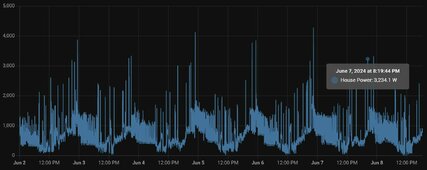So i set up my small array to handle essentials, I only went with two 380w panels mainly for the voltage as this was a greater PV power production than I actually needed.
Now there's talk in the house of a larger system to power everything but grid tie is more trouble than it's worth here so I'm thinking of sticking with off-grid hybrid.
Total peak draw is around the 4kw mark (adding more power monitoring in the coming weeks to cover the outbuildings as I only have monitoring on the main house to know for sure) so I'm looking at a daye 5kw system average draw is only about 1-2kw so I'm guessing I should look at just enough panels to cover that rather than peak and let the grid take care of any spikes is this a correct way of thinking?
Because of the heat I lean towards flooded deep cycles, also I'm not planning on using batteries regularly only as backups in case of outage which brings me to my next question.
As were planing on using Grid at night I'm thinking of a changeover switch so we're drawing from the grid directly rather than going through the inverter is this silly thinking any suggestions on how I would wire this? I'm thinking contactor on the grid side I control with the PV panel output, so grid as primary source & solar as secondary meaning either I switch off the grid or we get a power cut it swaps to PV/battery.
Now there's talk in the house of a larger system to power everything but grid tie is more trouble than it's worth here so I'm thinking of sticking with off-grid hybrid.
Total peak draw is around the 4kw mark (adding more power monitoring in the coming weeks to cover the outbuildings as I only have monitoring on the main house to know for sure) so I'm looking at a daye 5kw system average draw is only about 1-2kw so I'm guessing I should look at just enough panels to cover that rather than peak and let the grid take care of any spikes is this a correct way of thinking?
Because of the heat I lean towards flooded deep cycles, also I'm not planning on using batteries regularly only as backups in case of outage which brings me to my next question.
As were planing on using Grid at night I'm thinking of a changeover switch so we're drawing from the grid directly rather than going through the inverter is this silly thinking any suggestions on how I would wire this? I'm thinking contactor on the grid side I control with the PV panel output, so grid as primary source & solar as secondary meaning either I switch off the grid or we get a power cut it swaps to PV/battery.



